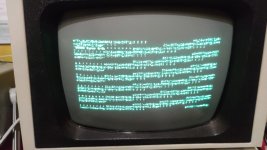Desperado,
I mentioned on one of your other threads recently, that while I'm not keen on the idea of replacing IC's off the bat, in an attempt to repair faults, it does appear that the 2114 IC in the PET turns out to feature in most repairs, when there is a defect that suggests it could be a problem in the video RAM area.
Since there are a small number of 2114's in the PET, I think it is reasonable in these cases to simply remove the originals, socket them and fit known good IC's.
It would be a good time saver and also it eliminates the most common known cause of trouble in the video ram system. It is still possible of course to have other faults in the video RAM's control & interface system, at least if the video RAM is known good, it helps to track any remaining faults down with the scope.
I bought up a large number of different brand 2114 (and 4116 DRAM) IC's for testing, and have testers for them and have screened all of the stock, and even in these new old stock parts, the occasional one in 20 or 30 or so is defective . They certainly appear to be fragile and quite vulnerable to failure, perhaps more than any IC type I know.
It is interesting how the 2114's (and 4116's) fail, simply because they are aged rather than related to running time. Many old PETs that have been unused/un-powered for decades and when powered up, have defective 2114 and 4116 chips in them. Occasionally a VIA or PIA fails , yet mostly, the 74 series logic chips are ok, with the occasional failure and surprisingly, given the complexity, the CPU's appear generally robust.


